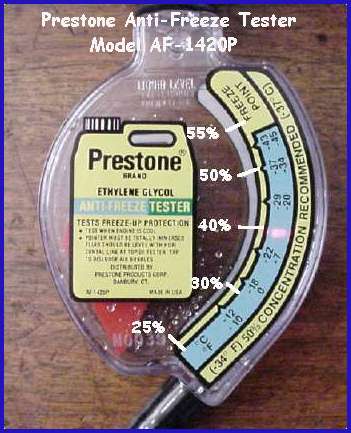Which of these statements is true or false:
1. Using 100% anti-freeze/coolant in your engine radiator will NOT decrease the cooling ability of your cooling system.
2. Using regular tap water, especially water that is considered hard is perfectly fine to mix with engine coolant, and will not over time cause any deposits to form in the cooling system.
3. Distilled and deionized water are not at all the same and neither should be used in an engine cooling system, use regular tap water.
4. Straight water in a cooling system will actually cool better than a 50/50 or 100% antifreeze mixture.
OK, questions 1, 2, and three are totally FALSE, question 4 is a trick question, it is TRUE but, it is not good to use only water in your cars cooling system.
Here are some interesting factoids:
If you drain your cooling system completely and refill it with 100% antifreeze, it will actually run hotter than it would with a 50/50 mix or straight water. I recently proved this by picking up the wrong jug (not a 50/50 mix) and filling my system with almost pure coolant. The net result was the engine ran a LOT hotter than it did prior to the service. When I drained out 50% of the cooling system capacity and refilled with water, the system then ran cool as it should. I made no other changes.
Concentrated antifreeze in a cooling system should never be used without adding water. At least 40% of the mixture should be water. If antifreeze is mixed with distilled water at the ratio of one part antifreeze to one part water, the freeze protection will be down to –34°F and boil- up to 265°F that is if using 15 PSI pressure cap.
The question comes up: Do I use regular tap water when mixing my coolant and water together? No, you should use distilled water or better yet, de-ionized water. The reason for this is that tap water has minerals that can form deposits inside the radiator and the cooling system passages of your engine. And over a long period of time they can lead to over-heating.
For best all-around protection, use a 50:50 mixture of antifreeze and distilled or deionized water. Coolant should not be mixed with hard tap water. Hard tap water has excessive calcium and magnesium deposits that can cause scaling, which will result in inadequate heat transfer. Use only soft or de-ionized water that is not treated with salts or chlorides. (OEMs publish limits in parts per million (ppm) for hardness, chlorides, sulfates and total dissolved solids for the water used to dilute antifreeze.)
For most applications, distilled and deionized water are the same thing. Both are just water with ions removed. Distilled water has been deionised by distillation as apposed to another technique such as ion exchange chromotography. The end product is the same and either can be used. Most labs will not have distilled water anyway even if some people still call it distilled rather than deionised.
You can buy distilled water at the pharmacy CHEAP! At CVS it is $.99 a gallon. The most I have seen it sell for is $1.98 Amazon sells distilled water for $19/gallon...it's a total rip-off. Go to the pharmacy or Walmart. Look for distilled water that has NOT been flavor enhanced. Flavor enhanced means they put back in salts and other minerals to make it taste 'better'. Desani water, a coca cola product, has more than a dozen additives for example to 'help the flavor.'
The safest and best solution is to purchase a 50/50 mix of coolant and water, premix. All coolant manufacturers use distilled/deionized water to reduce the coolant concentration. Else, you can save a few bucks, buy distilled water at the CVS pharmacy and mix it 50/50 or better yet 40/60 (water/coolant).
1. Using 100% anti-freeze/coolant in your engine radiator will NOT decrease the cooling ability of your cooling system.
2. Using regular tap water, especially water that is considered hard is perfectly fine to mix with engine coolant, and will not over time cause any deposits to form in the cooling system.
3. Distilled and deionized water are not at all the same and neither should be used in an engine cooling system, use regular tap water.
4. Straight water in a cooling system will actually cool better than a 50/50 or 100% antifreeze mixture.
OK, questions 1, 2, and three are totally FALSE, question 4 is a trick question, it is TRUE but, it is not good to use only water in your cars cooling system.
Here are some interesting factoids:
If you drain your cooling system completely and refill it with 100% antifreeze, it will actually run hotter than it would with a 50/50 mix or straight water. I recently proved this by picking up the wrong jug (not a 50/50 mix) and filling my system with almost pure coolant. The net result was the engine ran a LOT hotter than it did prior to the service. When I drained out 50% of the cooling system capacity and refilled with water, the system then ran cool as it should. I made no other changes.
Concentrated antifreeze in a cooling system should never be used without adding water. At least 40% of the mixture should be water. If antifreeze is mixed with distilled water at the ratio of one part antifreeze to one part water, the freeze protection will be down to –34°F and boil- up to 265°F that is if using 15 PSI pressure cap.
The question comes up: Do I use regular tap water when mixing my coolant and water together? No, you should use distilled water or better yet, de-ionized water. The reason for this is that tap water has minerals that can form deposits inside the radiator and the cooling system passages of your engine. And over a long period of time they can lead to over-heating.
For best all-around protection, use a 50:50 mixture of antifreeze and distilled or deionized water. Coolant should not be mixed with hard tap water. Hard tap water has excessive calcium and magnesium deposits that can cause scaling, which will result in inadequate heat transfer. Use only soft or de-ionized water that is not treated with salts or chlorides. (OEMs publish limits in parts per million (ppm) for hardness, chlorides, sulfates and total dissolved solids for the water used to dilute antifreeze.)
For most applications, distilled and deionized water are the same thing. Both are just water with ions removed. Distilled water has been deionised by distillation as apposed to another technique such as ion exchange chromotography. The end product is the same and either can be used. Most labs will not have distilled water anyway even if some people still call it distilled rather than deionised.
You can buy distilled water at the pharmacy CHEAP! At CVS it is $.99 a gallon. The most I have seen it sell for is $1.98 Amazon sells distilled water for $19/gallon...it's a total rip-off. Go to the pharmacy or Walmart. Look for distilled water that has NOT been flavor enhanced. Flavor enhanced means they put back in salts and other minerals to make it taste 'better'. Desani water, a coca cola product, has more than a dozen additives for example to 'help the flavor.'
The safest and best solution is to purchase a 50/50 mix of coolant and water, premix. All coolant manufacturers use distilled/deionized water to reduce the coolant concentration. Else, you can save a few bucks, buy distilled water at the CVS pharmacy and mix it 50/50 or better yet 40/60 (water/coolant).






